The high-speed train from Vienna to Budapest was quite pleasant. A quick metro ride and a very short walk later we arrived at the apartment. The building was old and the grungy foyer had me a little nervous but I was super pleased with the apartment itself: two bedrooms, two baths, totally modernized, with a full kitchen and very spacious. It was so nice that it made the rental in Vienna look bad, plus it was even cheaper at $79 a night. It was also very well located in the coolest part of town with tons of popular restaurants and bars just around the corner.
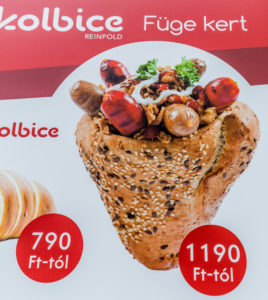
Kolbice anyone?
Based on our AirBnB host’s suggestion, we walked around the corner to get dinner at the Street Food Karavan which is essentially a courtyard that houses a variety of permanent food trucks. It’s much nicer than it sounds and very popular – it was packed. Bill tried a Kolbice which is a pretzel cone filled with mini sausages and sauerkraut and I tried a real Cheese burger, a fried block of cheese on a bun with red onion marmalade and chili mayo – no meat. It tasted pretty good, but it was a hot mess. For dessert we discovered Kürtőskalács, or in English – chimney cake. They are basically a sweet dough wrapped around a metal rolling pin, cooked on an open flame rotisserie and then rolled in sugar and whatever other delicious topping you like. Our first was Coconut and it was fabulous! Wish I had one now (me too).
Even closer to our apartment was one of Budapest’s most famous bars, Szimpla Kert. Szimpla was the first of Budapest’s “ruin pubs”, which is where they take a ruined building, make it just safe enough to occupy and then open a bar or restaurant. The creators of Szimpla originally leased the space intending a full renovation but ran out of cash part way through. In order to raise some money they decided to temporarily open a bar so they hit flea markets and 2nd hand stores for furniture. The bar was such a hit they scrapped their original plans and simply kept expanding the bar.
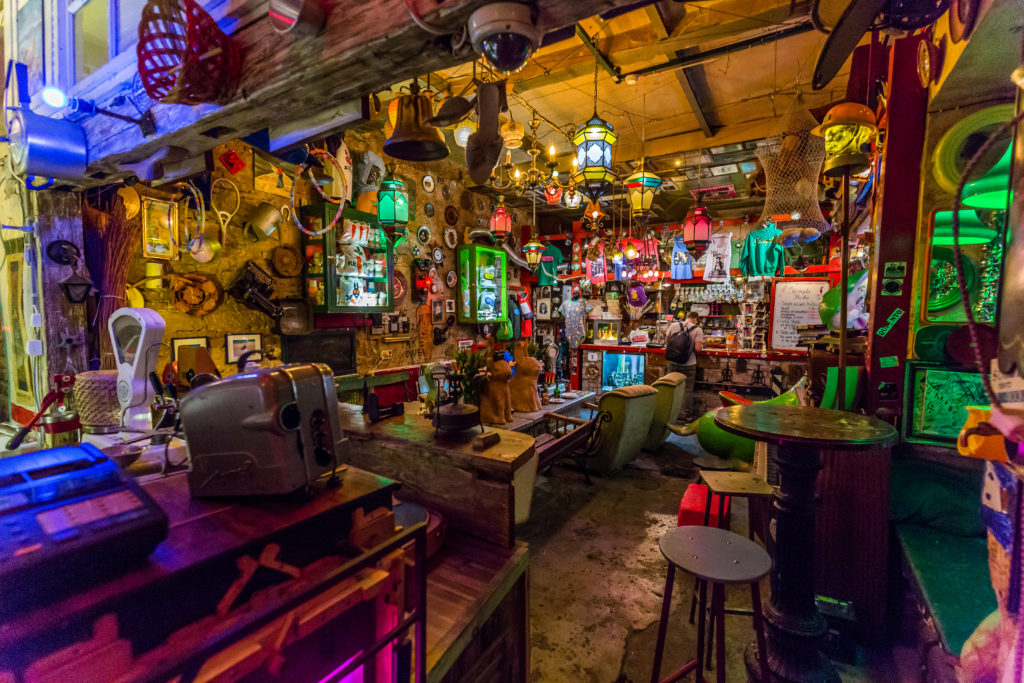
Szimpla Ruin Pub
The rest as the say is History. The walls are crumbling and covered with graffiti, everything is mismatched cast offs, and the décor can best be described as “tons of junk”. Today there are lots of these Ruin Pubs all over Budapest. On Sunday’s they convert it into a farmer’s market. Very cool spot.
Budapest in general is best described as a “funky” town. It was a stark contrast to Vienna’s pristine buildings and manicured gardens. Budapest has a lot more un-restored buildings, and is visibly trashier. This is not to say that it wasn’t beautiful. They have been using their European Union money to renovate and several of their main sites were wonderful but that money apparently can only go so far. We took our usual bike tour the day after we arrived, and once again enjoyed it. In fact this tour was even better than the Vienna tour because it ended with a stop at a café for Re’tes (strudel), the cream cheese and sour cherry was the best.
Budapest is the capital of Hungary and was once two separate cities, Buda on the west of the Danube and Pest on the east. Buda has the Castle district and is more residential. Pest is the urban side and has most of the major city sights including St Stephen’s and the Parliament. Like all cities divided by a river the bridges are key. Budapest has 8 bridges across the Danube each with a different look and story. Chain bridge is the oldest opening for traffic in 1849 and Megyeri is the newest, opening in 2008. The view of the city is fantastic from both sides of the Danube, at least when there aren’t any cruise ships in the way. We had considered a River Cruise for this trip. Bill’s parents have taken several and loved them but we decided we wanted to spend more time in fewer cities.

Inner Courtyard – Buda Castle
Once again we got our bearings and a feel for the city from our bike tour. Although we definitely wanted to spend some more time at the major tourist sites we also wanted something a little different. I guess we had seen (and extensively photographed) enough beautiful buildings while we were in Vienna. First up though was a site seeing hike. Buda Castle as you might expect, is on the Buda side of the Danube on the top of a hill. While Uber would have come in handy the service is not available in Budapest so we took the bus as close as we could get. The castle, a World Heritage Site, was originally built in 1265. It was destroyed in 1686, and then rebuilt over the centuries. Only a portion of the original wall that surrounded the castle remains but it is still a very impressive structure and it is lit up beautifully at night. The Monday that we visited was a public holiday, Whit Monday, and there was some type of festival on the castle grounds. The courtyards and walkways were full of vendors and food hawkers. We had a Langos for lunch which is like a pizza brushed with garlic butter instead of tomato sauce and topped with sour cream and cold shredded cheese. It was not bad but not great either. There were games for the kids, a puppet show and a few people in folk costumes. One of the most interesting stands was a hand powered carousel for the kids. It was a hot day and Bill was glad that he didn’t have to crank that thing to keep it spinning. Trivia note: Buda Castle was used as a location for Katy Perry’s video “Firework” (https://www.youtube.com/watch?v=QGJuMBdaqIw)

Stairs leading to Fisherman’s Bastion
After the castle we headed farther up the castle district to visit Matthias Church and Fisherman’s Bastion. Bill wanted to walk over to see Mary Magdalene Church but I needed a beer and a break so I found a cafe while he kept walking (I’d love to say she really missed out but that would be a stretch. It was kind of interesting to see a 20+ foot free standing window but it wasn’t life changing). Matthias Church on the other hand was amazing and has one of the most completely decorated interiors we have ever seen. Fisherman’s Bastion was a bright white (obviously some of the EU money was spent here) and provided wonderful views of the Parliament buildings and the Pest side. The Bastion was built to protect one side of the castle district, and was defended by fishermen.
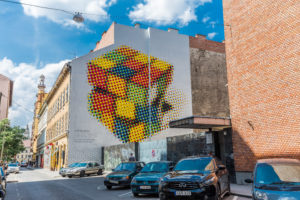
a hometown invention
Bill found us a free (for tip) alternative walking tour of the city. The 3 hour tour was called alternative because it focused on street art and off the beaten track locations rather than the typical tourist attractions (most of the stops were actually in the same neighborhood as our apartment, the Jewish Quarter). We had done something like this in Melbourne so we were intrigued. Budapest’s approach to street art was much more controlled and the art itself was less respected by the residents. The city accepts proposals from building owners for sites and from artists for designs and then makes decisions. The art itself is great and adds so much to the character of the area so it was disappointing to see several of the pieces tagged by graffiti or partially covered with permanent advertising.

Main Altar – St Stephen’s
St Stephen’s Basilica is the most important church in Hungary. It is named in honor of Stephen, the first King of Hungary and houses his right hand (supposedly) in a separate altar which people pray at based on St Stephen’s history of performing miracles. The basilica is also the final resting place for a soccer player. Ferenc Puskas is considered one of the best soccer players of all time and upon his death millions of Hungarians took to the streets to mourn (I just don’t see the same thing happening in Canada when Wayne Gretsky dies). The church took 50 years to build and was only finished in 1905. Bill and I climbed the 364 narrow, winding steps to the top of the bell towers to get pictures. It was a tight squeeze in areas, but the views were worth the effort. The entire city and the Danube were fanned out below us. The interior of St Stephen’s is beautiful, with really amazing stained glass, massive doors, patterned walls, and frescos on the domed ceiling. The exterior of the building was also really cool. From the front, it looked like it was a typical square church, but from the back it was a rounded dome with several levels of terraces. In front of the church is a plaza with several open air cafes which were always full. One day as we were passing by we saw a large crowd of kids and then a minute later a guy dress like a very tall leprechaun with the coolest bubble maker ever. It was made of two rods with thin rope tied into a bunch of squares. He would dip it in a bucket of soap and then spread it out and the breeze created hundreds of bubbles each time.
It was fun to watch the kids enjoying the show.
We’d seen the parliament buildings (picture at top of post) on our bike tour and while wandering on the Buda side of the river so we decided it would be the focus of a night time photo walk. On the tour we were told that the building is the 3rd largest Parliament in the world and considered by many as the most beautiful. It was built in 1896 during the last real boom economy in Hungary and at the time was considered by most of the population as an unnecessary extravagance. The money spent on the 691 rooms decorated with 500,000 precious stones and 90 lbs of gold could have been used to build a complete city for 30,000 people including all the infra-structure and housing. Today, the government uses less than a third of the space.
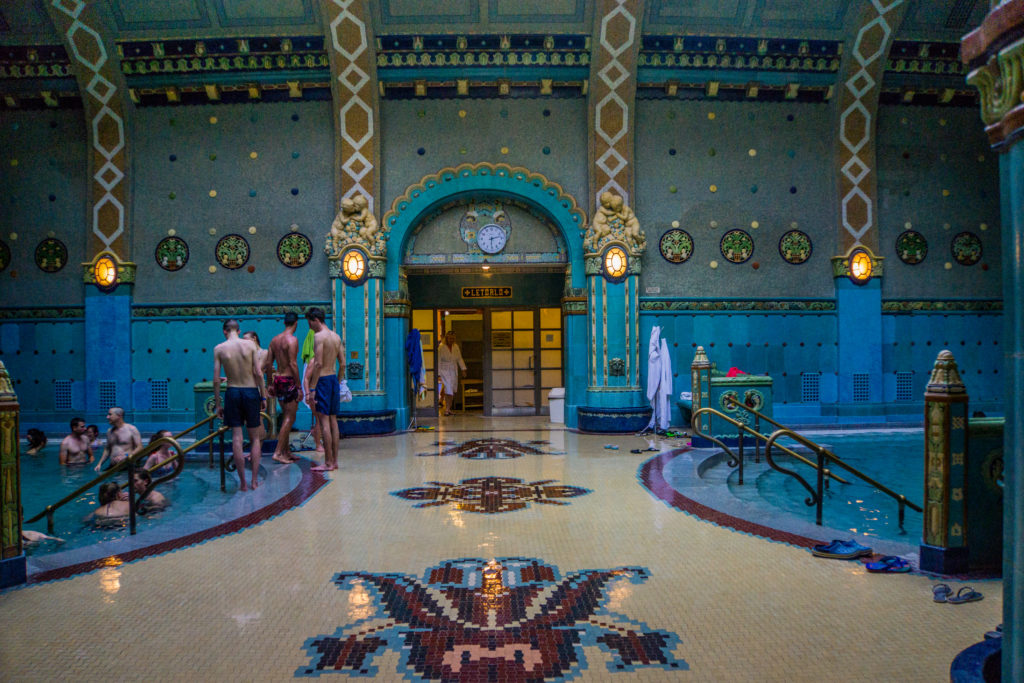
Gellert Baths
Budapest is famous for its thermal springs and the bath house is a significant part of the local culture. These large impressive buildings are part high end Spa, part real mineral baths and mostly large swimming pools (filled with mineral water) with lounging decks. We took a break from pounding the pavement to visit Gellert Baths. They have eleven pools at various temperatures, two of which are outside, and one is a wave pool. The water is rich in minerals and recommended for alleviating many joint ailments. Just in case the water wasn’t the magic cure it was supposed to be, I booked a deep tissue hot rock massage – awesome. Each pool has the temperature posted on the wall, and we got in the hottest one they had, which was actually not that hot at 102. It was very nice to just relax for an afternoon, and the interior of the building was lovely. It was Art Nouveau in style, with beautiful mosaic floors and walls, stained glass, and pools lined with columns and arches. I felt a little weird taking pictures, but nobody seemed to mind.
I was feeling pretty good when we left the bath so Bill decided that would be a good time to hike up Gellert Hill to the Citadel and the highest point in the area for some more photos. The path was pretty steep and I was a little hot and sweaty by the time we reached to top. Fortunately, for him, Bill bought me a Cider and we sat down to enjoy the view. On the hike down we passed some food vendors, one of which was selling Chimney Cake filled with soft serve ice cream. We were very tempted but since it was almost dinner time we decided to restrain ourselves (I won’t make that mistake again).
The next day we took the bus out to the suburbs to visit the Chocolate Museum. In 1902 it was the hunting castle of Count Wagner in the middle of a wildlife area. Hard to believe this little house was once considered a castle. It was stuffed with all things chocolate as you’d expect. We were the only people there for the tour that day (and I’m not sure they get a lot of visitors). Our guide showed us each room and told us all about the history of chocolate in Hungary while feeding us different types of chocolate along the way. We saw cool antique tins, and some very old chocolates that were covered in hand painted ceramic.
Apparently this was a method for high end storage and shipping.
The Museum was actually created by a man who loved chocolate but made his money as an importer, mostly of alcohol, and the basement definitely reflected that. It was basically a huge bar. Since we were essentially on a private tour the guide took us down to see it. The beverage of choice was Palinka, which is the Hungarian equivalent to Russian Vodka. The word palinka means “to burn” and it definitely does. It has a minimum alcohol content of 35.7% but the ‘good stuff’ is up to 70%. It comes in almost every fruit flavor imaginable and in tourist areas it is sold in hand blown bottles with all kinds of glass figures inside. Hungarians like to start their day with small shot and take a little more at every meal.
The next day we took the bus out to the suburbs to visit the Chocolate Museum. In 1902 it was the hunting castle of Count Wagner in the middle of a wildlife area. Hard to believe this little house was once considered a castle. It was stuffed with all things chocolate as you’d expect. We were the only people there for the tour that day (and I’m not sure they get a lot of visitors). Our guide showed us each room and told us all about the history of chocolate in Hungary while feeding us different types of chocolate along the way.
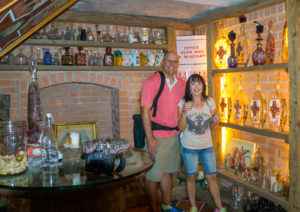
Palinka Tasting
We saw cool antique tins, and some very old chocolates that were covered in hand painted ceramic. Apparently this was a method for high end storage and shipping. The Museum was actually created by a man who loved chocolate but made his money as an importer, mostly of alcohol, and the basement definitely reflected that. It was basically a huge bar. Since we were essentially on a private tour the guide took us down to see it. The beverage of choice was Palinka, which is the Hungarian equivalent to Russian Vodka. The word palinka means “to burn” and it definitely does. It has a minimum alcohol content of 35.7% but the ‘good stuff’ is up to 70%. It comes in almost every fruit flavor imaginable and in tourist areas it is sold in hand blown bottles with all kinds of glass figures inside. Hungarians like to start their day with small shot and take a little more at every meal.
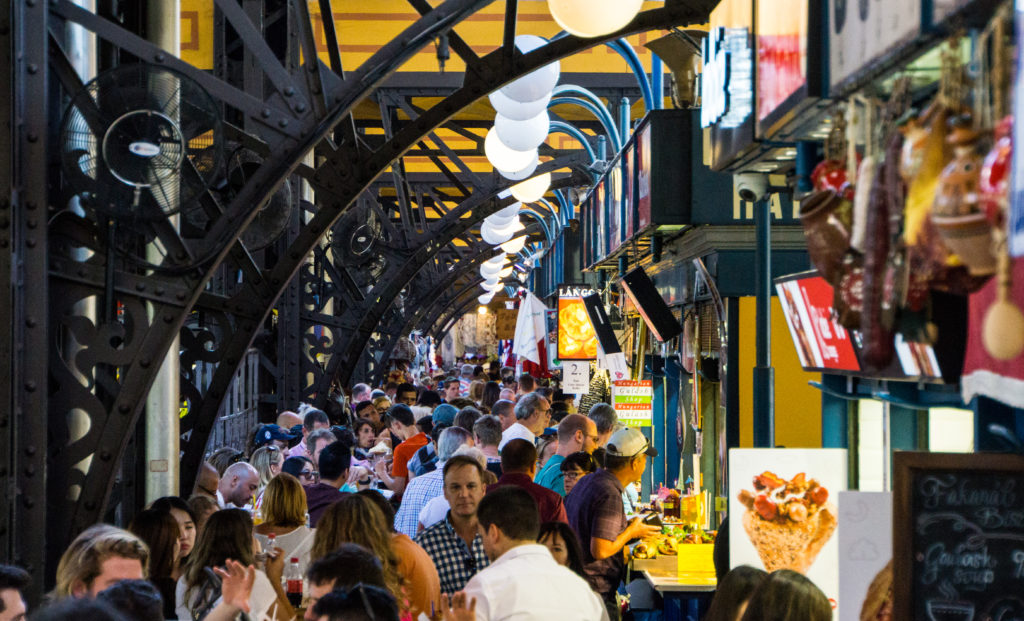
Central Market Hall
Goulash is the national dish, so we found a nice place in the Jewish Quarter to try some. It was served in a small bowl with a puff pastry top.
Delish!! We sampled more pastries (big surprise there), including Dobros Torte, a five-layer cake with chocolate frosting and caramel topping, and I tried many more strong beverages (another big surprise). We checked out the Central Market Hall, a three story, 100,000 square foot building housing tons of stalls selling fruits, meats, pastries, candy, spices, spirits, and Hungarian crafts. I found some awesome cream buns (not that she was looking specifically for cream buns but after eating it, she did send me back to get another one). Beyond the great food, you have to love the European culture. So many people sitting around on weekdays in outdoor bars and restaurants, from early morning till late into the evenings, drinking and socializing. We wondered more than once what they do for a living, and how is it they seem to have so much leisure time? Even during our 14 months of traveling we rarely stopped to smell the roses (take pictures, lots and lots of pictures but not stop to smell them). Makes me wonder when and if we’ll ever learn to slow down and just enjoy life.
Our train to Vienna left in the late afternoon so we had a half day to waste. We decided to visit the zoo. It got mixed reviews on trip advisor but included a botanical garden and we wanted something a little different to do for a few hours. The zoo was much like I remember from childhood with very poor enclosures. Many of the animals were just on dirt, or in concrete cages. The aquariums and terrariums were dirty, and many were empty. It was just overall not a good environment for them. 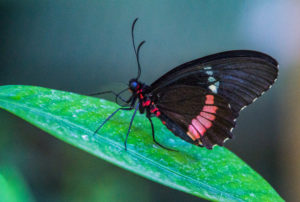 The botanical garden was nonexistent other than some flowers along the pathways and a small display of Bonsai trees. Clearly they were decades behind what I would expect for a zoo in a major city. The only benefit was that we were able to get much closer to the animals since they were in such small enclosures. As we were leaving we discovered they had a butterfly house which entertained us for a while longer.
The botanical garden was nonexistent other than some flowers along the pathways and a small display of Bonsai trees. Clearly they were decades behind what I would expect for a zoo in a major city. The only benefit was that we were able to get much closer to the animals since they were in such small enclosures. As we were leaving we discovered they had a butterfly house which entertained us for a while longer.
Late afternoon, we caught our train back to Vienna. We had accidentally picked a much lower class train for our return trip. The train was much older, hot and stuffy with not enough room for our giant suitcases, and we were stuck in middle seats. Thus, began our long commute home. We over-nighted at the Vienna airport hotel, which was actually not too bad, caught an early flight to Heathrow on Saturday morning and then our final flight to Dallas. Although we booked the aisle and the window seats hoping that British Airways wouldn’t put anyone between us, our plan didn’t work. I gave up my aisle seat and moved into the middle next to Bill. The young guy who sat next to me turned out to be an elephant keeper at the Dallas Zoo which we discovered when he saw me editing my zoo pics and asked about them. The return trip is always such a whipping. We were very glad to be home at last.
When we get a chance to visit Europe again, for a much longer stay, we will definitely make Budapest a base to visit nearby countries from. Loved it!!
You can find all of out Budapest photos at https://www.flickr.com/photos/bill_and_dessa/albums/72157682964157073/with/35619998286/
Post Author: Dessa (with editorial comments by Bill in Italics)

Love it. Thanks for sharing!